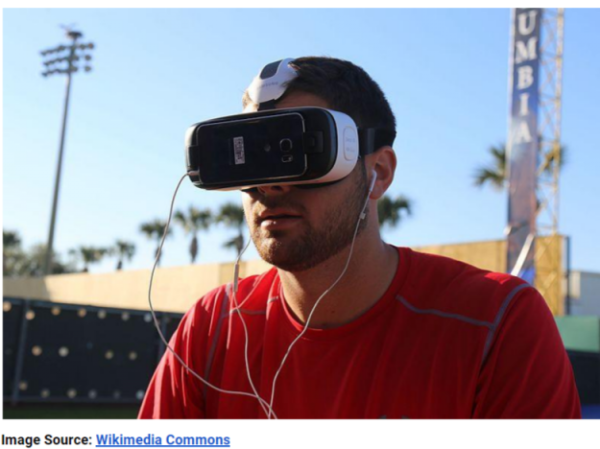by Frankie Wallace
When we talk about technology in the sports arena, it’s often about how new inventions are used for entertainment purposes. Up-to-date technology is consistently being integrated into stadiums and sports arenas around the country, and attending any professional sports event will prove that to you. These inventions help to broadcast games to more people, ensure that those in nosebleed sections are aware of the game’s details, and are a big part of fancy halftime shows.
Augmented reality (AR) and virtual reality (VR) tools are some of the newest technological devices being used in the sports arena. For instance, the combination of drones and VR will soon be used for broadcasting games to people at home with a new perspective. However, something we don’t usually touch on publicly is the incorporation of these technologies within athlete training.
VR and the technology surrounding and interacting with it may be what’s up-and-coming for training baseball players. The MLB is beginning to use VR tech in order to find, recruit, and train its best team members. VR’s place in baseball starts off the field, but is making its way from locker rooms and scout meetings to the field itself.
Off The Field
Toward the end of 2017, SportTechie revealed that two undisclosed MLB clubs were using specific hitting simulations created by TrinityVR. They claimed that the simulation collected the best data for professional prospect’s batting skills. Accordingly, the data is compiled from stats and game observations, which is inputted and analyzed by the software itself.
Because of the precise calculations these and similar VR systems offer, hitters are able to prepare for particular pitchers by simply bringing up the opponent’s data in the system. This will offer training that is technologically aligned with game evidence. Notably, it is a step forward from the similar ProBatter technology that has been used since the late 90s.
The use of VR in baseball training is still up and coming. EON Sports VR CEO Brendan Reilly told Fortune that less than half of MLB professional teams are using their technology. With EON, TrinityVR, and other competitors growing in popularity, one could speculate that these machines will be common practice in MLB training within just a few years.
On The Field
In addition to VR off the field, using AR on the field is something that’s coming to fruition as well. Obviously, baseball players aren’t able to use such technology mid-game or mid-practice, but their trainers are. Most of this AR technology is used for purposes of recording and replaying data.
The best example of this was mechanized by a team of developers called Blue who used Google Glass to obtain real-time information on players during games. Pitching speeds, batting averages, and scoreboard stats were listed at faster speeds than even ESPN could offer or obtain during a game. Blue is primarily made for baseball viewers, but could be easily modified for trainers.
Now, imagine if a coach or analyst for a team could use Google Glass during practice as a means to analyze a player’s stats in real time. This could mean something as specific as real-time updates on how fast they pitch. With this technology, coaches could revamp how they best train and challenge a player’s abilities. To our knowledge, technology like this is yet to be widely used in this way, but the tapping of AR technologies in data analysis and training could be just around the corner.
Technology and Scouting
Continuing with AR, there is actual technology being used so sports fans can watch games as if they were in the stands while on their couches at home. Imagine if scouts tapped into this same kind of AR in order to save travel costs and observed players practice from afar. This could additionally reduce pressure that some players feel by seeing scouts actually in the stands.
Blue and similar programs could be used in this manner as well. If a scout is in the stands at practice and observing potential players, they could analyze and track their stats as they watch. Ultimately, this could streamline the scouting process because the numbers would be more readily available and concretely observed than before.
Keeping the potential of machine learning in mind, there’s also the possibility that scouters could be rendered useless. If this technology is gaining and observing accurate insights about baseball players, why does a human need to make final decisions? With the right algorithms, it’s possible that computers could do the scouting, and scouts could be jobless. This may not be as simple as it sounds, but it’s still something that is being considered. Only time will tell how scouting and technology go together.
As VR and AR expand, their uses will too. Whether that’s VR headsets for activities relating to professional sports or for social activities like Pokemon Go, our entire futures could be transformed by this technology. We’ll have to see though. In the case of baseball, hopefully it just improves the nature of the game and is able to enhance its fun, yet leave its humanity in tact.










